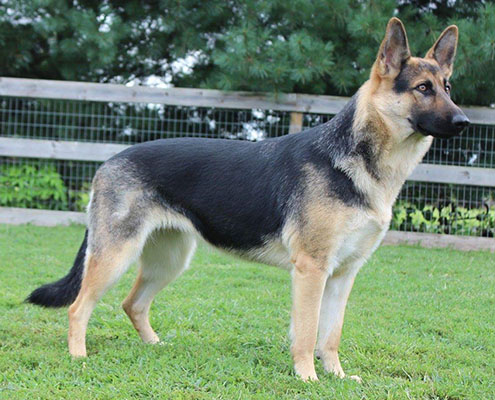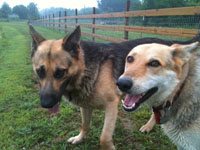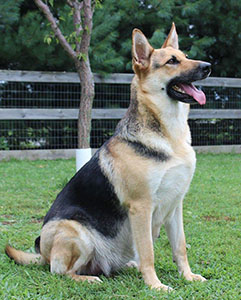Sugar Creek Farms
Lets Meet Our Resident German Shepherds
Gretel


Morgan


Buddy


Bethany


German Shepherds- some interesting facts
"Deutscher Schaferhund," German- meaning "German Shepherd Dog." The German Shepherd is a very strong and alert breed. They have a noble appearance with a strong and chiseled head. They have medium sized eyes that are dark and almond shaped. Their ears are somewhat pointed and open toward the front. They stand very erect when at attention. Their skulls are sloped into a long wedge shaped muzzle. Their noses are black and they have strongly developed jaws with teeth that meet in a scissors bite.
The German Shepherd dog has a strong neck that is muscular and long, but always in proportion to the rest of his body. Their chests are deep and filled out. Their legs are strong and muscular and their feet are short and compact.

German Shepherds are working dogs developed originally for herding and guarding sheep. Since that time, however, because of their strength, intelligence, trainability and obedience, German Shepherds around the world are often the preferred breed for many types of work, including search-and-rescue, police and military roles and even acting. Because German Shepherds make great additions to the family as companion dogs, gentle nature and good temperment, they are the second most popular dog in the United States of America.
Intelligence
German Shepherds were bred specifically for their intelligence, a trait for which they are now famous. Shepherds have the ability to learn simple tasks after only five repetitions and obeyed the first command given 95% of the time. Coupled with their strength, this trait makes the breed desirable as police, guard and search and rescue dogs, as they are able to quickly learn various tasks and interpret instructions better than other large breeds.
Temperament
 German Shepherds are highly active dogs and described in breed standards as self-assured. The breed is marked by a willingness to learn and an eagerness to have a purpose. They are curious which makes them excellent guard dogs and suitable for search missions. They can become over-protective of their family and territory, especially if not socialized correctly. They are not inclined to become immediate friends with strangers. German Shepherds are highly intelligent and obedient.
German Shepherds are highly active dogs and described in breed standards as self-assured. The breed is marked by a willingness to learn and an eagerness to have a purpose. They are curious which makes them excellent guard dogs and suitable for search missions. They can become over-protective of their family and territory, especially if not socialized correctly. They are not inclined to become immediate friends with strangers. German Shepherds are highly intelligent and obedient.
Stats
The German Shepherd, is a breed of large-sized dog that originated in Germany. German Shepherds are a relatively new breed of dog, with their origin dating to 1899.
Life span: 9 to 13 years
Temperament: Watchful, Alert, Curious, Obedient, Loyal, Confident, Courageous, Intelligent
Colors: Grey, Sable, Black & Tan, Blue, Red & Black, Black & Silver, Liver, Black, White
Height: Male: 24-26 inches (60-65 cm), Female: 22-24 inches (55-60 cm)
Weight: Male: 77.2-94.8 lbs (35-43 kg), Female: 55.1-72.8 lbs (25-33 kg)
Origin: Germany
What are those Acronyms and Abbreviations "OFA Hip Certified, AKC and NPRi"?
German Shepherds are carefully bread to exclude certain congenital disorders. Be sure to check with your choice breeder before you take your new puppy home. But what do these things mean?
AKC: American Kennel Club, Canine Health Foundation is a nonprofit organization dedicated to the prevention and treatment of diseases in all dogs. Since 1995, the AKC has been awarding grants to scientists and professionals to advance canine health research, while providing professional information and resources for today’s dog owner. read more » AKC
NPRi: North American Purebred Registry, Inc. (NAPRi) is a professional dog registry service; providing service to the United States and its territories. read more » NAPRi
Canine Hip Dysplasia (CHD): As with many large breed dogs, German shepherds are prone to canine hip dysplasia (CHD), a dog skeletal condition that can be inherited or caused by a traumatic fracture or other environmental factors. CHD occurs from malformation of the ball and joint socket of one or both hips (the hip joint is called the coxofemoral joint).
Veterinarians will diagnose canine hip dysplasia after X-rays of the hips and pelvis reveal that the ball (head of the femur) and hip socket (in the pelvis) don’t fit perfectly together. Instead of sliding smoothly and creating fluid motion, this “loose” hip rubs on the socket resulting in painful bone spurs that can cause pain in the hip joint, lameness, or even degenerative joint disease. After exploring the signs of canine hip dysplasia in German shepherds, let’s look at treatment options and other hip and joint problems. read more » Hip Dysplasia
DNA tested, Degenerative Myelopathy, OFA Hip Certified: Degenerative Myelopathy is a debilitating disease that causes gradual paralysis in many dog breeds. It is caused by a degeneration of the spinal cord that onsets typically between 8 and 14 years of age. It presents first with the loss of coordination of the hind legs. read more » Degenerative Myelopathy Orthopedic Foundation

 all rights reserved.
all rights reserved.